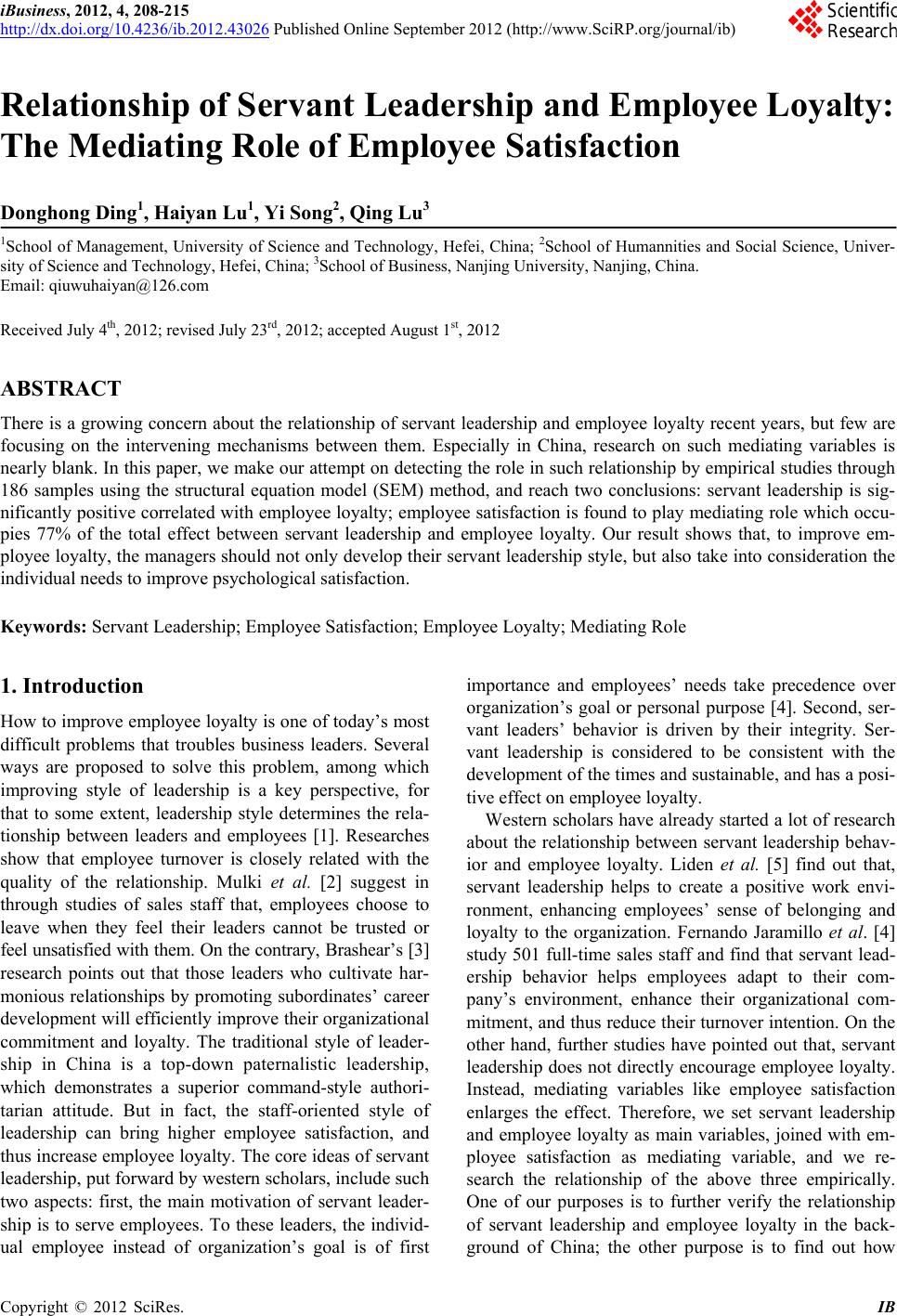 iBusiness, 2012, 4, 208-215 http://dx.doi.org/10.4236/ib.2012.43026 Published Online September 2012 (http://www.SciRP.org/journal/ib) Relationship of Servant Leadership and Employee Loyalty: The Mediating Role of Employee Satisfaction Donghong Ding1, Haiyan Lu1, Yi Song2, Qing Lu3 1School of Management, University of Science and Technology, Hefei, China; 2School of Humannities and Social Science, Univer- sity of Science and Technology, Hefei, China; 3School of Business, Nanjing University, Nanjing, China. Email: qiuwuhaiyan@126.com Received July 4th, 2012; revised July 23rd, 2012; accepted August 1st, 2012 ABSTRACT There is a growing concern about the relationship of servant leadership and employee loyalty recent years, but few are focusing on the intervening mechanisms between them. Especially in China, research on such mediating variables is nearly blank. In th is paper, we make our attempt on detecting the role in such r elationship by empirical stud ies through 186 samples using the structural equation model (SEM) method, and reach two conclusions: servant leadership is sig- nificantly positive correlated with employee loyalty; emplo yee satisfaction is found to play mediating role which occu- pies 77% of the total effect between servant leadership and employee loyalty. Our result shows that, to improve em- ployee loyalty, the managers shou ld not only develop their servant leadersh ip style, but also take into consideration the individual needs to improve psy c h ol o gi cal sat i s fact i on. Keywords: Servant Leadership; Employee Satisfaction; Employee Loyalty; Mediating Role 1. Introduction How to improve employee loyalty is one of today’s most difficult problems that troubles business leaders. Several ways are proposed to solve this problem, among which improving style of leadership is a key perspective, for that to some extent, leadership style determines the rela- tionship between leaders and employees [1]. Researches show that employee turnover is closely related with the quality of the relationship. Mulki et al. [2] suggest in through studies of sales staff that, employees choose to leave when they feel their leaders cannot be trusted or feel unsatisfied with them. On the contrary, Brashear’s [3] research points out that those leaders who cultivate har- monious relationships by promoting subordinates’ career development will efficiently improve their organizational commitment and loyalty. The traditional style of leader- ship in China is a top-down paternalistic leadership, which demonstrates a superior command-style authori- tarian attitude. But in fact, the staff-oriented style of leadership can bring higher employee satisfaction, and thus increase employee loyalty. The cor e ideas of serv ant leadership, put forward by western scholars, include such two aspects: first, the main motivation of servant leader- ship is to serve employees. To these leaders, the individ- ual employee instead of organization’s goal is of first importance and employees’ needs take precedence over organization’s goal or personal purpose [4]. Second, ser- vant leaders’ behavior is driven by their integrity. Ser- vant leadership is considered to be consistent with the development of the times and sustainable, and has a posi- tive effect on employee loyalty. Western scholars have already started a lot of research about the relationship between servant leadership behav- ior and employee loyalty. Liden et al. [5] find out that, servant leadership helps to create a positive work envi- ronment, enhancing employees’ sense of belonging and loyalty to the organization. Fernando Jaramillo et al. [4] study 501 full-time sales staff and find that servant lead- ership behavior helps employees adapt to their com- pany’s environment, enhance their organizational com- mitment, and thus reduce their turnover inten tion. On the other hand, further studies have pointed out that, servant leadership does not directly encourage employee loyalty. Instead, mediating variables like employee satisfaction enlarges the effect. Therefore, we set servant leadership and employee loyalty as main variables, joined with em- ployee satisfaction as mediating variable, and we re- search the relationship of the above three empirically. One of our purposes is to further verify the relationship of servant leadership and employee loyalty in the back- ground of China; the other purpose is to find out how Copyright © 2012 SciRes. IB 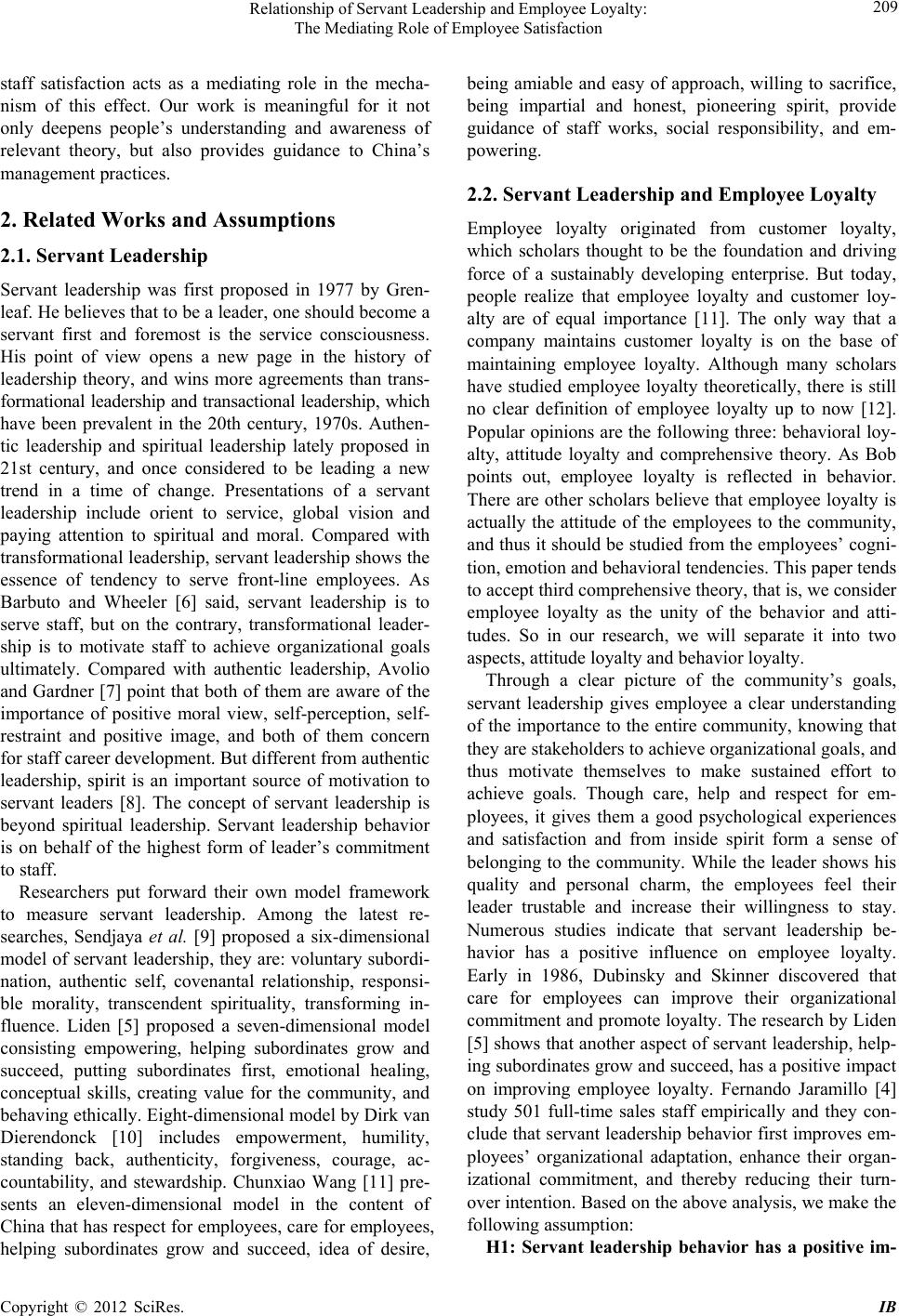 Relationship of Servant Leadership and Employee Loyalty: The Mediating Role of Employee Satisfaction 209 staff satisfaction acts as a mediating role in the mecha- nism of this effect. Our work is meaningful for it not only deepens people’s understanding and awareness of relevant theory, but also provides guidance to China’s management practices. 2. Related Works and Assumptions 2.1. Servant Leadership Servant leadership was first proposed in 1977 by Gren- leaf. He believes that to be a leader, one should become a servant first and foremost is the service consciousness. His point of view opens a new page in the history of leadership theory, and wins more agreements than trans- formational lea dership and transactional lead ership, which have been prevalent in the 20th century, 1970s. Authen- tic leadership and spiritual leadership lately proposed in 21st century, and once considered to be leading a new trend in a time of change. Presentations of a servant leadership include orient to service, global vision and paying attention to spiritual and moral. Compared with transformational leadership, servant leadership shows the essence of tendency to serve front-line employees. As Barbuto and Wheeler [6] said, servant leadership is to serve staff, but on the contrary, transformational leader- ship is to motivate staff to achieve organizational goals ultimately. Compared with authentic leadership, Avolio and Gardner [7] point that both of them are aware of the importance of positive moral view, self-perception, self- restraint and positive image, and both of them concern for staff career development. But different from authentic leadership, spirit is an important source of motivation to servant leaders [8]. The concept of servant leadership is beyond spiritual leadership. Servant leadership behavior is on behalf of the highest form of leader’s commitment to staff. Researchers put forward their own model framework to measure servant leadership. Among the latest re- searches, Sendjaya et al. [9] proposed a six-dimensional model of servant leadership, they are: voluntary subordi- nation, authentic self, covenantal relationship, responsi- ble morality, transcendent spirituality, transforming in- fluence. Liden [5] proposed a seven-dimensional model consisting empowering, helping subordinates grow and succeed, putting subordinates first, emotional healing, conceptual skills, creating value for the community, and behaving ethically. Eight-dimensional model by Dirk van Dierendonck [10] includes empowerment, humility, standing back, authenticity, forgiveness, courage, ac- countability, and stewardship. Chunxiao Wang [11] pre- sents an eleven-dimensional model in the content of China that has respect for employees, care for employees, helping subordinates grow and succeed, idea of desire, being amiable and easy of approach, willing to sacrifice, being impartial and honest, pioneering spirit, provide guidance of staff works, social responsibility, and em- powering. 2.2. Servant Leadership and Employee Loyalty Employee loyalty originated from customer loyalty, which scholars thought to be the foundation and driving force of a sustainably developing enterprise. But today, people realize that employee loyalty and customer loy- alty are of equal importance [11]. The only way that a company maintains customer loyalty is on the base of maintaining employee loyalty. Although many scholars have studied employee loyalty theoretically, there is still no clear definition of employee loyalty up to now [12]. Popular opinions are the following three: behavioral loy- alty, attitude loyalty and comprehensive theory. As Bob points out, employee loyalty is reflected in behavior. There are other scholars believe that employee loyalty is actually the attitude of the employees to the community, and thus it should be studied from the employees’ cogni- tion, emotion and behavioral tendencies. This paper tends to accept third comprehensive theory, that is, we consider employee loyalty as the unity of the behavior and atti- tudes. So in our research, we will separate it into two aspects, attitude loyalty and behavior loyalty. Through a clear picture of the community’s goals, servant leadership gives employee a clear understanding of the importance to the entire community, knowing that they are stakeholders to achieve organizational goals, and thus motivate themselves to make sustained effort to achieve goals. Though care, help and respect for em- ployees, it gives them a good psychological experiences and satisfaction and from inside spirit form a sense of belonging to the community. While the leader shows his quality and personal charm, the employees feel their leader trustable and increase their willingness to stay. Numerous studies indicate that servant leadership be- havior has a positive influence on employee loyalty. Early in 1986, Dubinsky and Skinner discovered that care for employees can improve their organizational commitment and promote loyalty. The research by Liden [5] shows that another aspect of servant leadership, help- ing subordinates grow and succeed, has a positive impact on improving employee loyalty. Fernando Jaramillo [4] study 501 full-time sales staff empirically and they con- clude that servant leadership behavior first improves em- ployees’ organizational adaptation, enhance their organ- izational commitment, and thereby reducing their turn- over intention. Based on th e above analysis, we make th e following assumption: H1: Servant leadership behavior has a positive im- Copyright © 2012 SciRes. IB 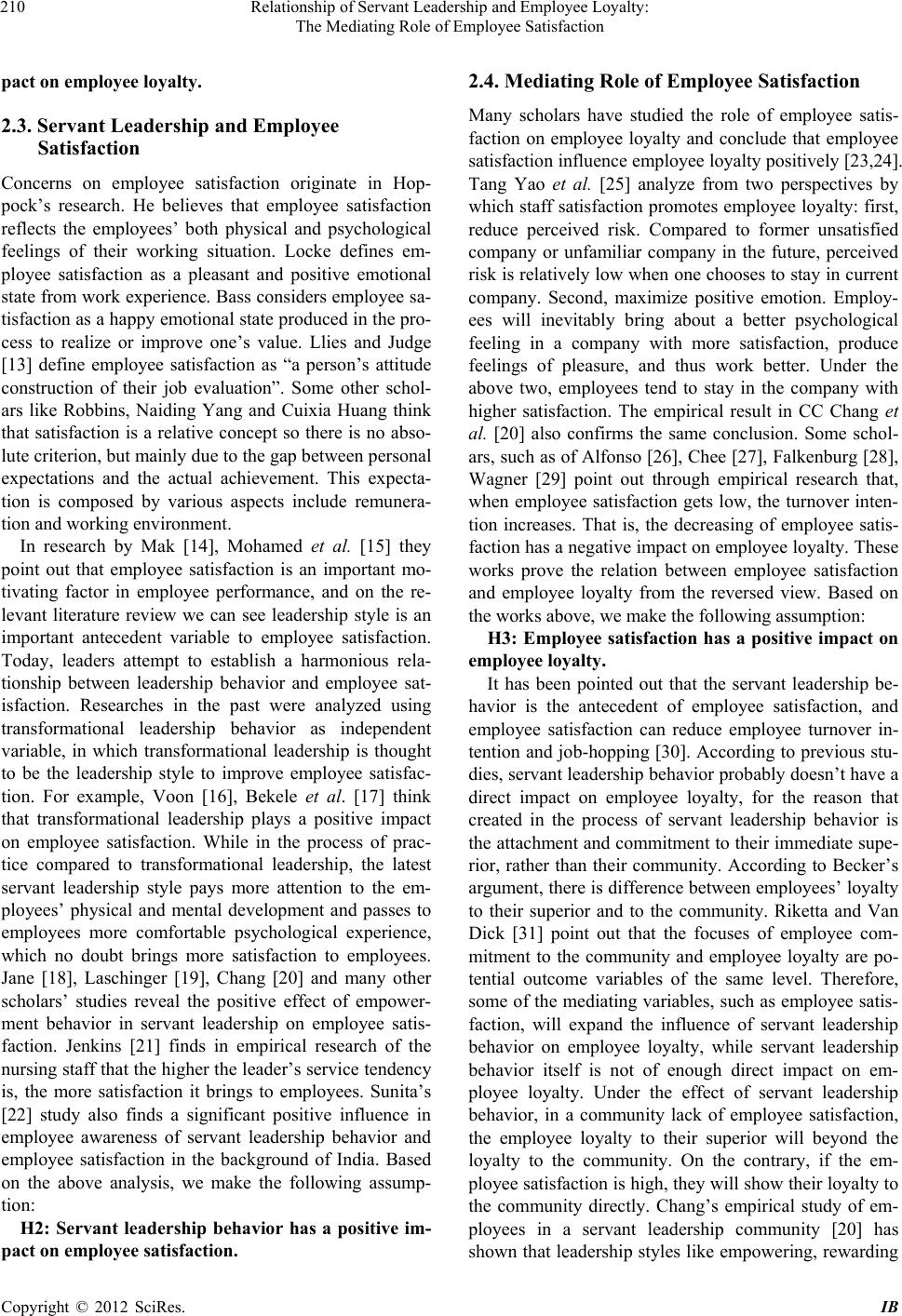 Relationship of Servant Leadership and Employee Loyalty: The Mediating Role of Employee Satisfaction 210 pact on employee loyalty. 2.3. Servant Leadership and Employee Satisfaction Concerns on employee satisfaction originate in Hop- pock’s research. He believes that employee satisfaction reflects the employees’ both physical and psychological feelings of their working situation. Locke defines em- ployee satisfaction as a pleasant and positive emotional state from work experience. Bass considers employee sa- tisfaction as a happy emotional state produced in the pro- cess to realize or improve one’s value. Llies and Judge [13] define employee satisfaction as “a person’s attitude construction of their job evaluation”. Some other schol- ars like Robbins, Naiding Yang and Cuixia Huang think that satisfaction is a relative concept so there is no abso- lute criterion, but mainly due to the gap between personal expectations and the actual achievement. This expecta- tion is composed by various aspects include remunera- tion and working environment. In research by Mak [14], Mohamed et al. [15] they point out that employee satisfaction is an important mo- tivating factor in employee performance, and on the re- levant literature review we can see leadership style is an important antecedent variable to employee satisfaction. Today, leaders attempt to establish a harmonious rela- tionship between leadership behavior and employee sat- isfaction. Researches in the past were analyzed using transformational leadership behavior as independent variable, in which transformational leadership is thought to be the leadership style to improve employee satisfac- tion. For example, Voon [16], Bekele et al. [17] think that transformational leadership plays a positive impact on employee satisfaction. While in the process of prac- tice compared to transformational leadership, the latest servant leadership style pays more attention to the em- ployees’ physical and mental development and passes to employees more comfortable psychological experience, which no doubt brings more satisfaction to employees. Jane [18], Laschinger [19], Chang [20] and many other scholars’ studies reveal the positive effect of empower- ment behavior in servant leadership on employee satis- faction. Jenkins [21] finds in empirical research of the nursing staff that the higher the leader’s service tendency is, the more satisfaction it brings to employees. Sunita’s [22] study also finds a significant positive influence in employee awareness of servant leadership behavior and employee satisfaction in the background of India. Based on the above analysis, we make the following assump- tion: H2: Servant leadership behavior has a positive im- pact on employee satisfaction. 2.4. Mediating Role of Employee Satisfaction Many scholars have studied the role of employee satis- faction on employee loyalty and conclude that employee satisfaction influence employee loyalty po sitively [23,24]. Tang Yao et al. [25] analyze from two perspectives by which staff satisfaction promotes employee loyalty: first, reduce perceived risk. Compared to former unsatisfied company or unfamiliar company in the future, perceived risk is relatively low when one choo ses to stay in current company. Second, maximize positive emotion. Employ- ees will inevitably bring about a better psychological feeling in a company with more satisfaction, produce feelings of pleasure, and thus work better. Under the above two, employees tend to stay in the company with higher satisfaction. The empirical result in CC Chang et al. [20] also confirms the same conclusion. Some schol- ars, such as of Alfonso [26], Chee [27], Falkenburg [28], Wagner [29] point out through empirical research that, when employee satisfaction gets low, the turnover inten- tion increases. That is, the decreasing of employee satis- faction has a negativ e impact on employee loyalty. These works prove the relation between employee satisfaction and employee loyalty from the reversed view. Based on the works above, we make the fo llowing assumption: H3: Employee satisfaction has a positive impact on employee loyalty. It has been pointed out that the servant leadership be- havior is the antecedent of employee satisfaction, and employee satisfaction can reduce employee turnover in- tention and job-hopping [30]. According to previous stu- dies, servant leadership behavior probably doesn’t have a direct impact on employee loyalty, for the reason that created in the process of servant leadership behavior is the attachment and commitment to their immediate supe- rior, rather than their community. According to Becker’s argument, there is difference between employees’ loyalty to their superior and to the community. Riketta and Van Dick [31] point out that the focuses of employee com- mitment to the community and employee loyalty are po- tential outcome variables of the same level. Therefore, some of the mediating variables, such as employee satis- faction, will expand the influence of servant leadership behavior on employee loyalty, while servant leadership behavior itself is not of enough direct impact on em- ployee loyalty. Under the effect of servant leadership behavior, in a community lack of employee satisfaction, the employee loyalty to their superior will beyond the loyalty to the community. On the contrary, if the em- ployee satisfaction is high, they will show their loyalty to the community directly. Chang’s empirical study of em- ployees in a servant leadership community [20] has shown that leadersh ip styles like empowering, rewarding Copyright © 2012 SciRes. IB 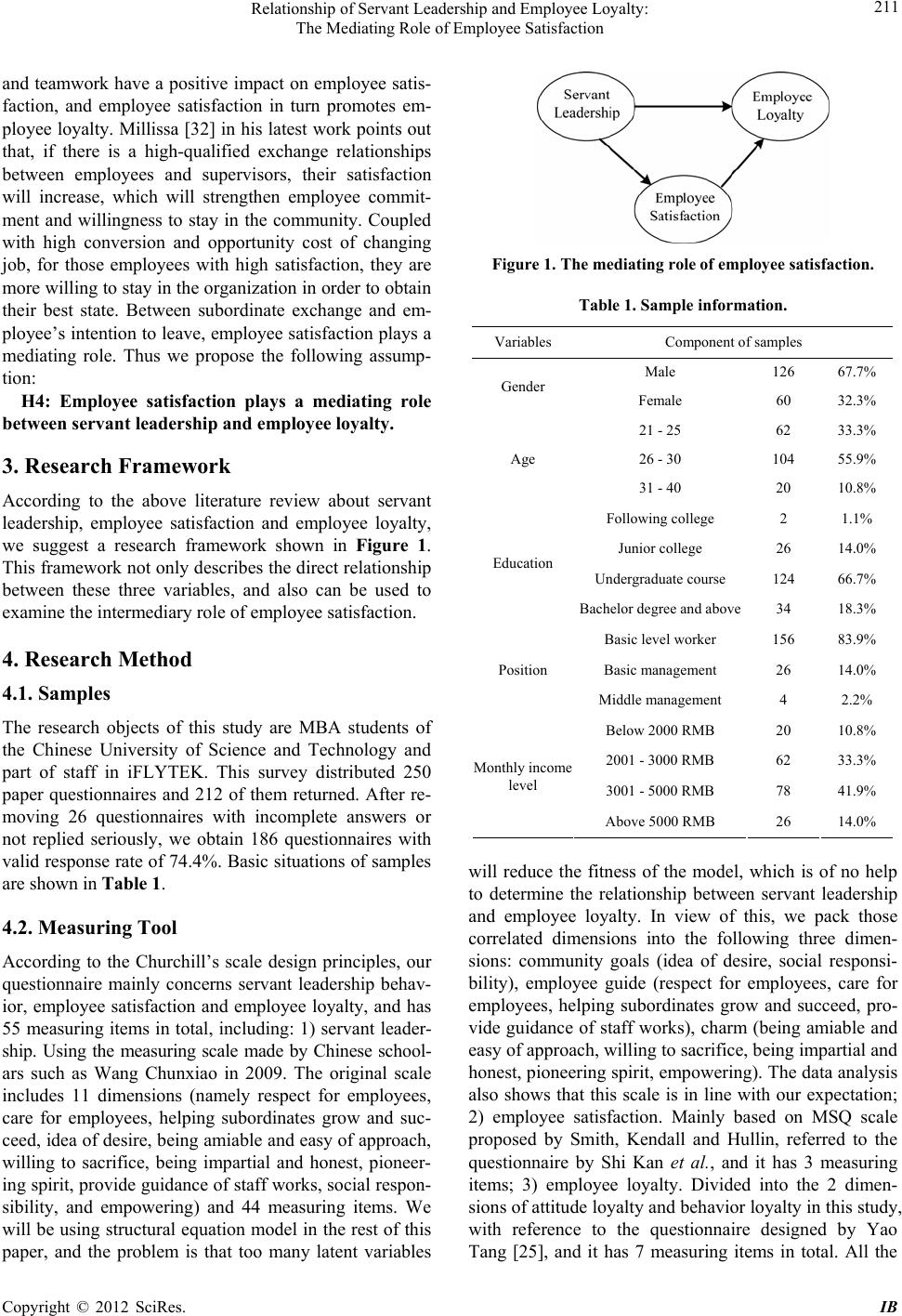 Relationship of Servant Leadership and Employee Loyalty: The Mediating Role of Employee Satisfaction 211 and teamwork have a positive impact on employee satis- faction, and employee satisfaction in turn promotes em- ployee loyalty. Millissa [32] in his latest work poin ts out that, if there is a high-qualified exchange relationships between employees and supervisors, their satisfaction will increase, which will strengthen employee commit- ment and willingness to stay in the community. Coupled with high conversion and opportunity cost of changing job, for those employees with high satisfaction, they are more willing to stay in the organization in order to obtain their best state. Between subordinate exchange and em- ployee’s intention to leave, employee satisfaction plays a mediating role. Thus we propose the following assump- tion: H4: Employee satisfaction plays a mediating role between servant leadership and employee loyalty. 3. Research Framework According to the above literature review about servant leadership, employee satisfaction and employee loyalty, we suggest a research framework shown in Figure 1. This framework not only describes the direct relationship between these three variables, and also can be used to examine the intermediary role of employee satisfaction. 4. Research Method 4.1. Samples The research objects of this study are MBA students of the Chinese University of Science and Technology and part of staff in iFLYTEK. This survey distributed 250 paper questionnaires and 212 of them returned. After re- moving 26 questionnaires with incomplete answers or not replied seriously, we obtain 186 questionnaires with valid response rate o f 74.4%. Basic situations of samples are shown in Table 1. 4.2. Measuring Tool According to the Churchill’s scale design principles, our questionnaire mainly concerns servant leadership behav- ior, employee satisfaction and employee loyalty, and has 55 measuring items in total, including: 1) servant leader- ship. Using the measuring scale made by Chinese school- ars such as Wang Chunxiao in 2009. The original scale includes 11 dimensions (namely respect for employees, care for employees, helping subordinates grow and suc- ceed, idea of desire, being amiable and easy of approach, willing to sacrifice, being impartial and honest, pioneer- ing spirit, pr ovide guidan ce of staff works, so cial respon- sibility, and empowering) and 44 measuring items. We will be using structural equatio n model in the rest of this paper, and the problem is that too many latent variables Figure 1. The mediating role of employee satisfaction. Table 1. Sample information. Variables Component of samples Male 126 67.7% Gender Female 60 32.3% 21 - 25 62 33.3% 26 - 30 104 55.9% Age 31 - 40 20 10.8% Following college 2 1.1% Junior college 26 14.0% Undergraduate course 124 66.7% Education Bachelor degree and above 34 18.3% Basic level worker 156 83.9% Basic management 26 14.0% Position Middle management 4 2.2% Below 2000 RMB 20 10.8% 2001 - 3000 RMB 62 33.3% 3001 - 5000 RMB 78 41.9% Monthly income level Above 5000 RMB 26 14.0% will reduce the fitness of the model, which is of no help to determine the relationship between servant leadership and employee loyalty. In view of this, we pack those correlated dimensions into the following three dimen- sions: community goals (idea of desire, social responsi- bility), employee guide (respect for employees, care for employees, helping subordinates grow and succeed, pro- vide guidance of staff works), charm (being amiable and easy of approach, willing to sacrifice, being impartial and honest, pioneering spirit, empowering). The data analysis also shows that this scale is in line with our expectation; 2) employee satisfaction. Mainly based on MSQ scale proposed by Smith, Kendall and Hullin, referred to the questionnaire by Shi Kan et al., and it has 3 measuring items; 3) employee loyalty. Divided into the 2 dimen- sions of attitude loyalty and behav ior loyalty in th is stud y, with reference to the questionnaire designed by Yao Tang [25], and it has 7 measuring items in total. All the Copyright © 2012 SciRes. IB 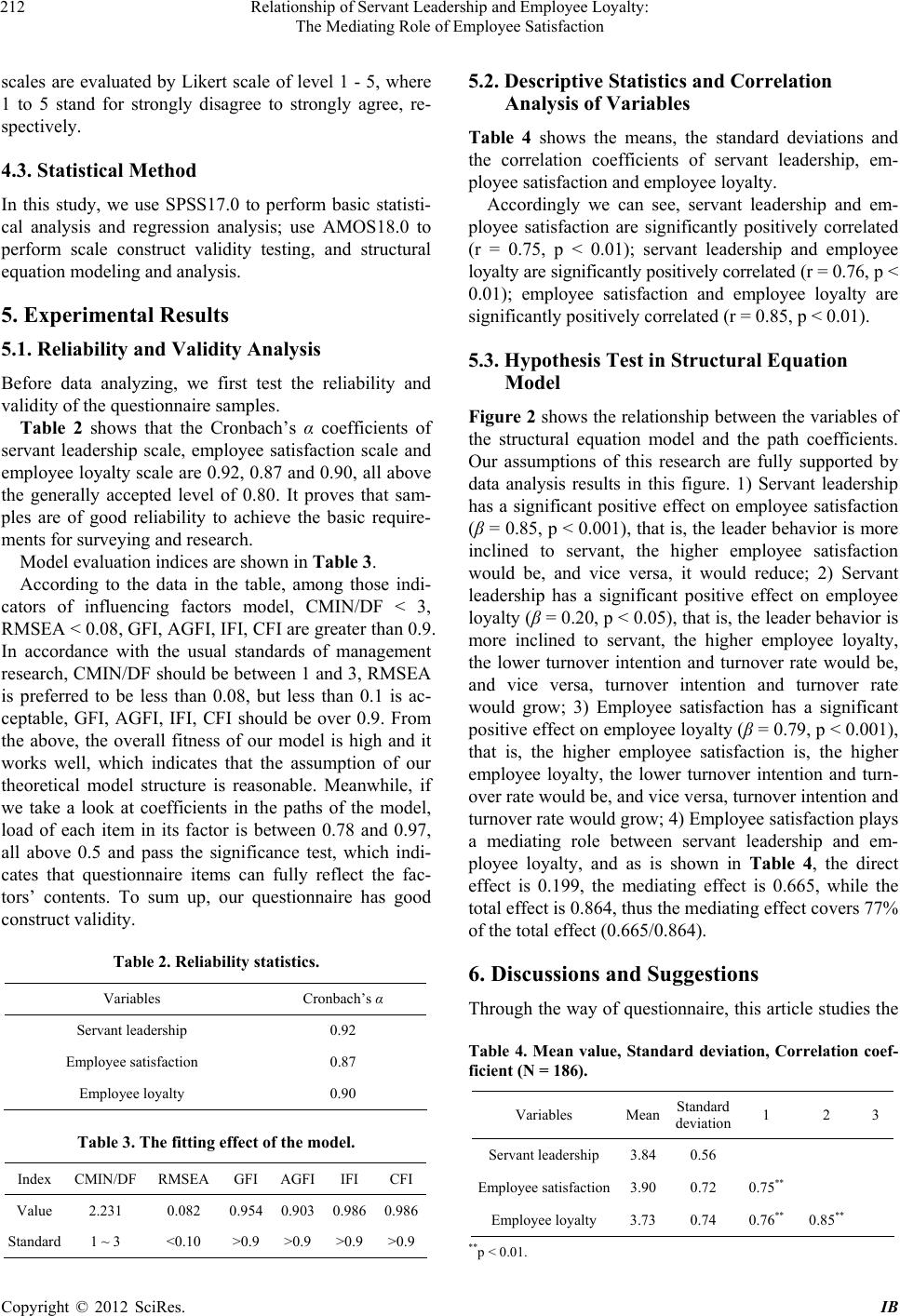 Relationship of Servant Leadership and Employee Loyalty: The Mediating Role of Employee Satisfaction 212 scales are evaluated by Likert scale of level 1 - 5, where 1 to 5 stand for strongly disagree to strongly agree, re- spectively. 4.3. Statistical Method In this study, we use SPSS17.0 to perform basic statisti- cal analysis and regression analysis; use AMOS18.0 to perform scale construct validity testing, and structural equation modeling and analysis. 5. Experimental Results 5.1. Reliability and Validity Analysis Before data analyzing, we first test the reliability and validity of the questionnaire samples. Table 2 shows that the Cronbach’s α coefficients of servant leadership scale, employee satisfaction scale and employee loyalty scale are 0.92, 0.87 and 0.90, all above the generally accepted level of 0.80. It proves that sam- ples are of good reliability to achieve the basic require- ments for surveying and research. Model evaluation indices are shown in Table 3. According to the data in the table, among those indi- cators of influencing factors model, CMIN/DF < 3, RMSEA < 0.08, GFI, AGFI, IFI, CFI are greater than 0.9. In accordance with the usual standards of management research, CMIN/DF should be between 1 and 3, RMSEA is preferred to be less than 0.08, but less than 0.1 is ac- ceptable, GFI, AGFI, IFI, CFI should be over 0.9. From the above, the overall fitness of our model is high and it works well, which indicates that the assumption of our theoretical model structure is reasonable. Meanwhile, if we take a look at coefficients in the paths of the model, load of each item in its factor is between 0.78 and 0.97, all above 0.5 and pass the significance test, which indi- cates that questionnaire items can fully reflect the fac- tors’ contents. To sum up, our questionnaire has good construct validity. Table 2. Reliability statistics. Variables Cronbach’s α Servant leadership 0.92 Employee satis fa c ti o n 0.87 Employee loy alty 0.90 Table 3. The fitting effect of the model. Index CMIN/DF RMSEA GFI AGFI IFI CFI Value 2.231 0.082 0.954 0.903 0.9860.986 Standard 1 ~ 3 <0.10 >0.9 >0.9 >0.9>0.9 5.2. Descriptive Statistics and Correlation Analysis of Variables Table 4 shows the means, the standard deviations and the correlation coefficients of servant leadership, em- ployee satisfaction and employee loyalty. Accordingly we can see, servant leadership and em- ployee satisfaction are significantly positively correlated (r = 0.75, p < 0.01); servant leadership and employee loyalty are significantly positively correlated (r = 0.76, p < 0.01); employee satisfaction and employee loyalty are significantly positively correlated (r = 0.85, p < 0.01). 5.3. Hypothesis Test in Structural Equation Model Figure 2 shows the relationship between the variables of the structural equation model and the path coefficients. Our assumptions of this research are fully supported by data analysis results in this figure. 1) Servant leadership has a significant positive effect on employee satisfaction (β = 0.85, p < 0.001), that is, the leader behavior is more inclined to servant, the higher employee satisfaction would be, and vice versa, it would reduce; 2) Servant leadership has a significant positive effect on employee loyalty (β = 0.20, p < 0.05), that is, the leader behavior is more inclined to servant, the higher employee loyalty, the lower turnover intention and turnover rate would be, and vice versa, turnover intention and turnover rate would grow; 3) Employee satisfaction has a significant positive effect on employee loyalty (β = 0.79, p < 0.001), that is, the higher employee satisfaction is, the higher employee loyalty, the lower turnover intention and turn- over rate would be, and vice versa, turnover intention and turnover rate would grow; 4) Employee satisfaction plays a mediating role between servant leadership and em- ployee loyalty, and as is shown in Table 4, the direct effect is 0.199, the mediating effect is 0.665, while the total effect is 0.864, thus the mediating effect co vers 77% of the total effect (0.665/0.864). 6. Discussions and Suggestions Through the way of questionnaire, this article stud ies the Table 4. Mean value, Standard deviation, Correlation coef- ficient (N = 186). Variables MeanStandard deviation 1 2 3 Servant leadership 3.840.56 Employee satis fa c ti o n3.900.72 0.75** Employee loy alty 3.730.74 0.76** 0.85** ** p < 0.01. Copyright © 2012 SciRes. IB 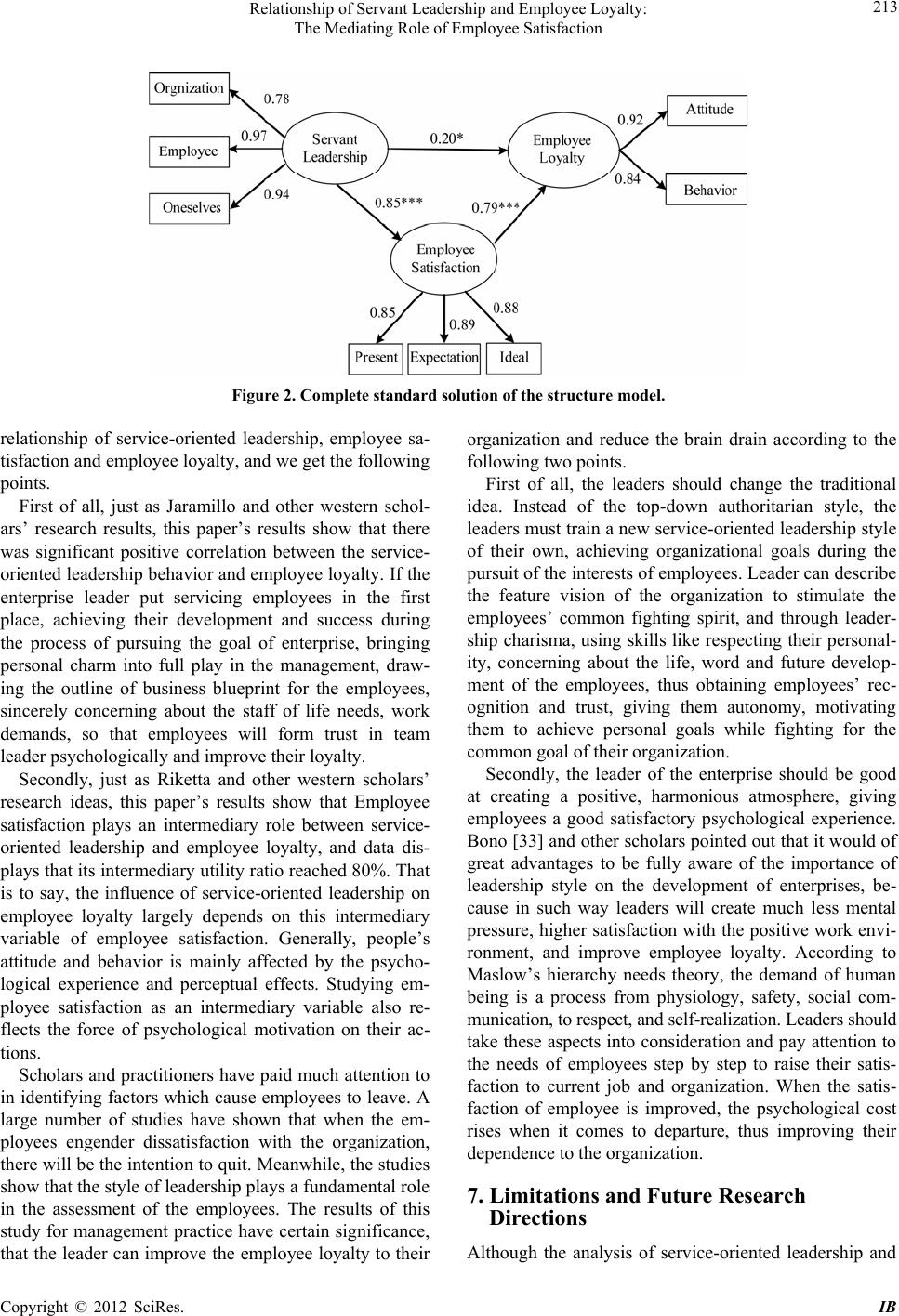 Relationship of Servant Leadership and Employee Loyalty: The Mediating Role of Employee Satisfaction Copyright © 2012 SciRes. IB 213 Figure 2. Complete standard solution of the structure model. relationship of service-oriented leadership, employee sa- tisfaction and employee loyalty, and we get the following points. First of all, just as Jaramillo and other western schol- ars’ research results, this paper’s results show that there was significant positive correlation between the service- oriented leadership behavior and employee loyalty. If the enterprise leader put servicing employees in the first place, achieving their development and success during the process of pursuing the goal of enterprise, bringing personal charm into full play in the management, draw- ing the outline of business blueprint for the employees, sincerely concerning about the staff of life needs, work demands, so that employees will form trust in team leader psychologically and improve their loyalty. Secondly, just as Riketta and other western scholars’ research ideas, this paper’s results show that Employee satisfaction plays an intermediary role between service- oriented leadership and employee loyalty, and data dis- plays that its intermediary utility ratio reached 80%. That is to say, the influence of service-oriented leadership on employee loyalty largely depends on this intermediary variable of employee satisfaction. Generally, people’s attitude and behavior is mainly affected by the psycho- logical experience and perceptual effects. Studying em- ployee satisfaction as an intermediary variable also re- flects the force of psychological motivation on their ac- tions. Scholars and practitioners have paid much attention to in identifying facto rs which cause employees to leave. A large number of studies have shown that when the em- ployees engender dissatisfaction with the organization, there will be the intentio n to quit. Meanwhile, the stud ies show that the style of leadership plays a fundamental role in the assessment of the employees. The results of this study for management practice have certain significance, that the leader can improve the employee loyalty to their organization and reduce the brain drain according to the following two points. First of all, the leaders should change the traditional idea. Instead of the top-down authoritarian style, the leaders must train a new service-oriented leadership style of their own, achieving organizational goals during the pursuit of the interests of employees. Leader can describe the feature vision of the organization to stimulate the employees’ common fighting spirit, and through leader- ship charisma, using skills like respecting their personal- ity, concerning about the life, word and future develop- ment of the employees, thus obtaining employees’ rec- ognition and trust, giving them autonomy, motivating them to achieve personal goals while fighting for the common goal of their organization. Secondly, the leader of the enterprise should be good at creating a positive, harmonious atmosphere, giving employees a good satisfactory psychological experience. Bono [33] and other scholars pointed out that it would of great advantages to be fully aware of the importance of leadership style on the development of enterprises, be- cause in such way leaders will create much less mental pressure, higher satisfaction with the positive work envi- ronment, and improve employee loyalty. According to Maslow’s hierarchy needs theory, the demand of human being is a process from physiology, safety, social com- munication, to respect, and self-realization. Leaders should take these aspects into con sideration and pay attention to the needs of employees step by step to raise their satis- faction to current job and organization. When the satis- faction of employee is improved, the psychological cost rises when it comes to departure, thus improving their dependence to the organization. 7. Limitations and Future Research Directions Although the analysis of service-oriented leadership and 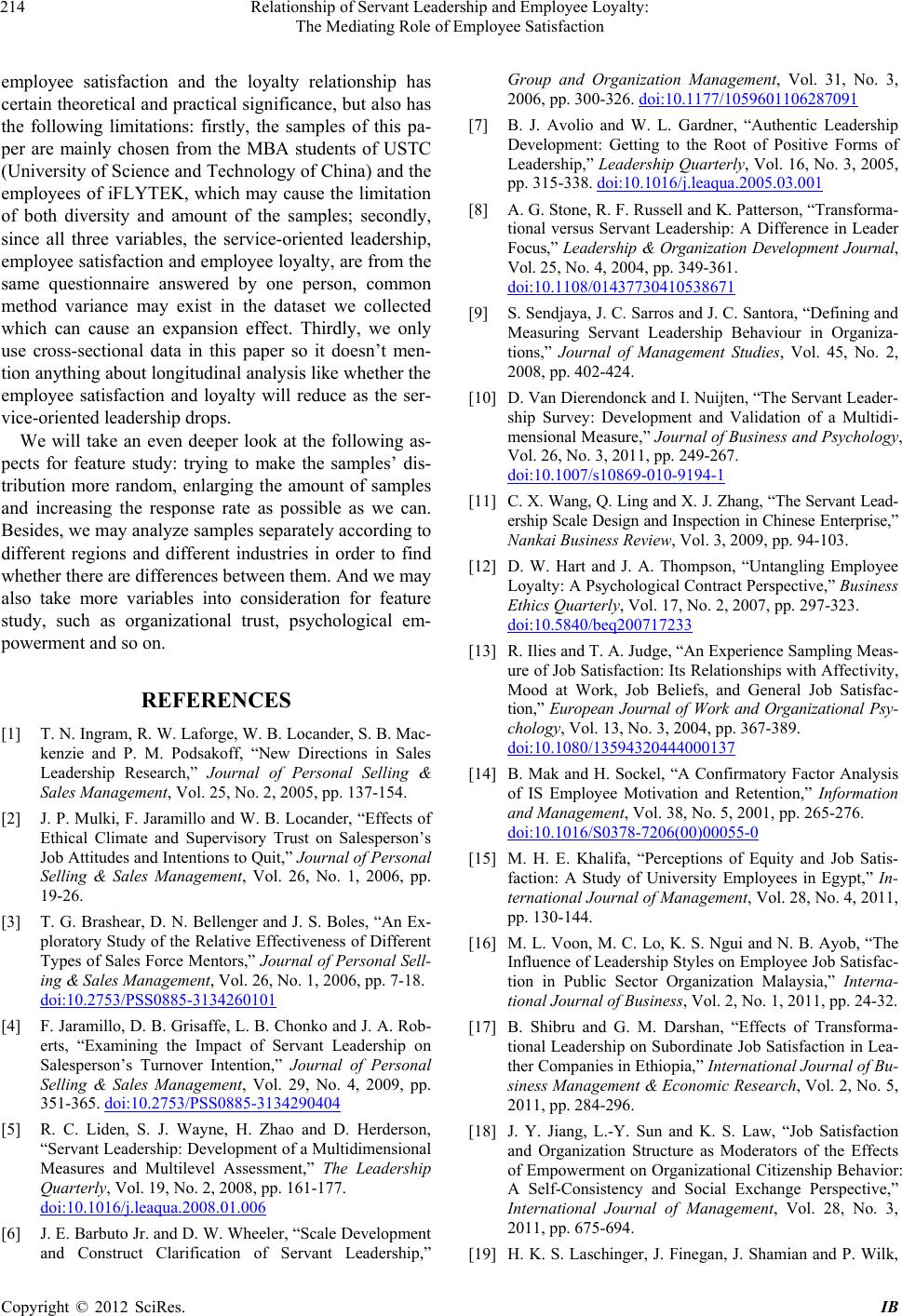 Relationship of Servant Leadership and Employee Loyalty: The Mediating Role of Employee Satisfaction 214 employee satisfaction and the loyalty relationship has certain theoretical and practical significance, but also has the following limitations: firstly, the samples of this pa- per are mainly chosen from the MBA students of USTC (University of Science and Technology of China) and the employees of iFLYTEK, which may cause the limitation of both diversity and amount of the samples; secondly, since all three variables, the service-oriented leadership, employee satisfaction and employee loyalty, are from the same questionnaire answered by one person, common method variance may exist in the dataset we collected which can cause an expansion effect. Thirdly, we only use cross-sectional data in this paper so it doesn’t men- tion anythi ng about long itudin al analysis like wh ether th e employee satisfaction and loyalty will reduce as the ser- vice-oriented leadership drops. We will take an even deeper look at the following as- pects for feature study: trying to make the samples’ dis- tribution more random, enlarging the amount of samples and increasing the response rate as possible as we can. Besides, we may analyze samples separately according to different regions and different industries in order to find whether there are differences between them. And we may also take more variables into consideration for feature study, such as organizational trust, psychological em- powerment and so on. REFERENCES [1] T. N. Ingram, R. W. Laforge, W. B. Locande r, S. B. Mac- kenzie and P. M. Podsakoff, “New Directions in Sales Leadership Research,” Journal of Personal Selling & Sales Management, Vol. 25, No. 2, 2005, pp. 137-154. [2] J. P. Mulki, F. Jaramillo and W. B. Locander, “Effects of Ethical Climate and Supervisory Trust on Salesperson’s Job Attitudes and Intentions to Quit,” Journal of Personal Selling & Sales Management, Vol. 26, No. 1, 2006, pp. 19-26. [3] T. G. Brashear, D. N. Bellenger and J. S. Boles, “An Ex- ploratory Study of the Relative Effectiveness of Different Types of Sale s Force Mentors,” Journal of Personal Sell- ing & Sales Management, Vol. 26, No. 1, 2006, pp. 7-18. doi:10.2753/PSS0885-3134260101 [4] F. Jaramillo, D. B. Grisaffe, L. B. Chonko and J. A. Rob- erts, “Examining the Impact of Servant Leadership on Salesperson’s Turnover Intention,” Journal of Personal Selling & Sales Management, Vol. 29, No. 4, 2009, pp. 351-365. doi:10.2753/PSS0885-3134290404 [5] R. C. Liden, S. J. Wayne, H. Zhao and D. Herderson, “Servant Leadership: Development of a Multidimensional Measures and Multilevel Assessment,” The Leadership Quarterly, Vol. 19, No. 2, 2008, pp. 161-177. doi:10.1016/j.leaqua.2008.01.006 [6] J. E. Barbuto Jr. and D. W. Wheeler, “Scale Development and Construct Clarification of Servant Leadership,” Group and Organization Management, Vol. 31, No. 3, 2006, pp. 300-326. doi:10.1177/1059601106287091 [7] B. J. Avolio and W. L. Gardner, “Authentic Leadership Development: Getting to the Root of Positive Forms of Leadership,” Leadership Quarterly, Vol. 16, No. 3, 2005, pp. 315-338. doi:10.1016/j.leaqua.2005.03.001 [8] A. G. Stone, R. F. Russell and K. Patterson, “Transforma- tional versus Servant Leadership: A Difference in Leader Focus,” Leadership & Organization Development Journal, Vol. 25, No. 4, 2004, pp. 349-361. doi:10.1108/01437730410538671 [9] S. Sendjaya, J. C. Sarros and J. C. Sa ntora, “Defining and Measuring Servant Leadership Behaviour in Organiza- tions,” Journal of Management Studies, Vol. 45, No. 2, 2008, pp. 402-424. [10] D. Van Dierendonck and I. Nuijten, “The Servant Leader- ship Survey: Development and Validation of a Multidi- mensional Measure,” Journal of Business and Psychology, Vol. 26, No. 3, 2011, pp. 249-267. doi:10.1007/s10869-010-9194-1 [11] C. X. Wang, Q. Ling and X. J. Zhang, “The Servant Lead- ership Scale Design and Inspection in Chinese Enterprise,” Nankai Business Review, Vol. 3, 2009, pp. 94-103. [12] D. W. Hart and J. A. Thompson, “Untangling Employee Loyalty: A Psychological Contract Perspective,” Business Ethics Quarterly, Vol. 17, No. 2, 2007, pp. 297-323. doi:10.5840/beq200717233 [13] R. Ilies and T. A. Judge, “An Experience Sampling Meas- ure of Job Satisfaction: Its Relationships with Affectivity, Mood at Work, Job Beliefs, and General Job Satisfac- tion,” European Journal of Work and Organizational Psy- chology, Vol. 13, No. 3, 2004, pp. 367-389. doi:10.1080/13594320444000137 [14] B. Mak and H. Sockel, “A Confirmatory Factor Analysis of IS Employee Motivation and Retention,” Information and Management, Vol. 38, No. 5, 2001, pp. 265-276. doi:10.1016/S0378-7206(00)00055-0 [15] M. H. E. Khalifa, “Perceptions of Equity and Job Satis- faction: A Study of University Employees in Egypt,” In- ternational Journal of Management, Vol. 28, No. 4, 2011, pp. 130-144. [16] M. L. Voon, M. C. Lo, K. S. Ngui and N. B. Ayob, “The Influence of Leadership Styles on Employee Job Satisfac- tion in Public Sector Organization Malaysia,” Interna- tional Journal of Business, Vol. 2, No. 1, 2011, pp. 24-32. [17] B. Shibru and G. M. Darshan, “Effects of Transforma- tional Leadership on Subordinate Job Satisfaction in Lea- ther Companies in Ethiopia,” International Journal of Bu- siness Management & Economic Research, Vol. 2, No. 5, 2011, pp. 284-296. [18] J. Y. Jiang, L.-Y. Sun and K. S. Law, “Job Satisfaction and Organization Structure as Moderators of the Effects of Empowerment on Organizational Citizenship Behavior: A Self-Consistency and Social Exchange Perspective,” International Journal of Management, Vol. 28, No. 3, 2011, pp. 675-694. [19] H. K. S. Laschinger, J. Finegan, J. Shamian and P. Wilk, Copyright © 2012 SciRes. IB 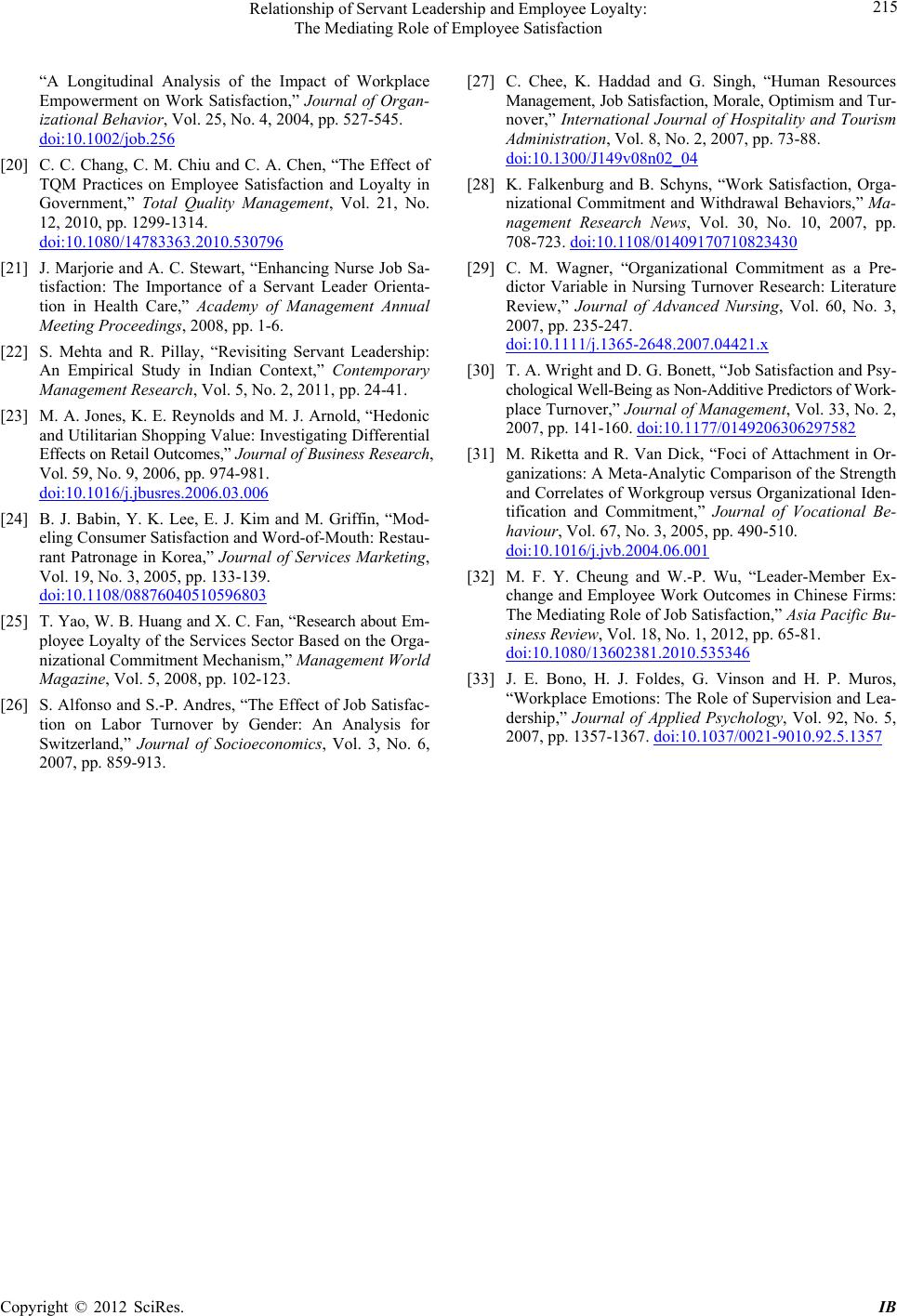 Relationship of Servant Leadership and Employee Loyalty: The Mediating Role of Employee Satisfaction Copyright © 2012 SciRes. IB 215 “A Longitudinal Analysis of the Impact of Workplace Empowerment on Work Satisfaction,” Journal of Organ- izational Behavior, Vol. 25, No. 4, 2004, pp. 527-545. doi:10.1002/job.256 [20] C. C. Chang, C. M. Chiu and C. A. Chen, “The Effect of TQM Practices on Employee Satisfaction and Loyalty in Government,” Total Quality Management, Vol. 21, No. 12, 2010, pp. 1299-1314. doi:10.1080/14783363.2010.530796 [21] J. Marjorie and A. C. Stewart, “Enhancing Nurse Job Sa- tisfaction: The Importance of a Servant Leader Orienta- tion in Health Care,” Academy of Management Annual Meeting Proceedings, 2008, pp. 1-6. [22] S. Mehta and R. Pillay, “Revisiting Servant Leadership: An Empirical Study in Indian Context,” Contemporary Management Research, Vol. 5, No. 2, 2011, pp. 24-41. [23] M. A. Jones, K. E. Reynolds and M. J. Arnold, “Hedonic and Utilitarian Shopping Value: Investigating Differential Effects on Retail Outcomes,” Journal of Business Research, Vol. 59, No. 9, 2006, pp. 974-981. doi:10.1016/j.jbusres.2006.03.006 [24] B. J. Babin, Y. K. Lee, E. J. Kim and M. Griffin, “Mod- eling Consumer Satisfaction and Word-of-Mouth: Restau- rant Patronage in Korea,” Journal of Services Marketing, Vol. 19, No. 3, 2005, pp. 133-139. doi:10.1108/08876040510596803 [25] T. Yao, W. B. Huang and X. C. Fan, “Research about Em- ployee Loyalty of the Services Sector Based on the Orga- nizational Commitment Mechanism,” Management World Magazine, Vol. 5, 2008, pp. 102-123. [26] S. Alfonso and S.-P. Andres, “The Effect of Job Satisfac- tion on Labor Turnover by Gender: An Analysis for Switzerland,” Journal of Socioeconomics, Vol. 3, No. 6, 2007, pp. 859-913. [27] C. Chee, K. Haddad and G. Singh, “Human Resources Management, Job Sati sfaction, Morale, Optimism and Tur- nover,” International Journal of Hospitality and Tourism Administration, Vol. 8, No. 2, 2007, pp. 73-88. doi:10.1300/J149v08n02_04 [28] K. Falkenburg and B. Schyns, “Work Satisfaction, Orga- nizational Commitment and Withdrawal Behaviors,” Ma- nagement Research News, Vol. 30, No. 10, 2007, pp. 708-723. doi:10.1108/01409170710823430 [29] C. M. Wagner, “Organizational Commitment as a Pre- dictor Variable in Nursing Turnover Research: Literature Review,” Journal of Advanced Nursing, Vol. 60, No. 3, 2007, pp. 235-247. doi:10.1111/j.1365-2648.2007.04421.x [30] T. A. Wright and D. G. Bonett, “Job Satisfaction and Psy- chological Well-Being as Non-Additive Predictors of Work- place Turnover,” Journal of Management, Vol. 33, No. 2, 2007, pp. 141-160. doi:10.1177/0149206306297582 [31] M. Riketta and R. Van Dick, “Foci of Attachment in Or- ganizations: A Meta-Analytic Comparison of the Strength and Correlates of Workgroup versus Organizational Iden- tification and Commitment,” Journal of Vocational Be- haviour, Vol. 67, No. 3, 2005, pp. 490-510. doi:10.1016/j.jvb.2004.06.001 [32] M. F. Y. Cheung and W.-P. Wu, “Leader-Member Ex- change and Employee Work Outcomes in Chinese Firms: The Mediating Role of Job Satisfaction,” Asia Pacific Bu- siness Review, Vol. 18, No. 1, 2012, pp. 65-81. doi:10.1080/13602381.2010.535346 [33] J. E. Bono, H. J. Foldes, G. Vinson and H. P. Muros, “Workplace Emotions: The Role of Supervision and Lea- dership,” Journal of Applied Psychology, Vol. 92, No. 5, 2007, pp. 1357-1367. doi:10.1037/0021-9010.92.5.1357
|